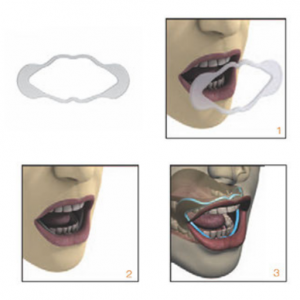Support: 606 716 128
NOSE STIMULATOR
WHAT IS A NOSE STIMULATOR?
The nose stimulator consists of two tubes that are joined by a stabilizing tape, and comprises a flat surface that makes direct contact with the nose septum, an exter-nal convex surface portion that tenses the nasal alae, a tab that stimulates the muscular insertions in the nasal alar area, and an external rim to prevent the tubes from accidentally hitting against the nose. The device comes in seven sizes, two for children (00 and 01) and five for adolescents and adults (1, 2, 3, 4,
and 5).
It stimulates perinasal muscular insertions in the alar region of the nose, reduces nasal airflow resistance, en-hancing nasal airflow, and restructures the nasal cartilage, thereby harmonizing the shape of the nasal pyramid. It is used to promote nasal airflow in patients who present with:
– Nasal passages collapse during inhalation
– Mouth breathing
– Snoring problems
– Sleep apnea
INDICATIONS
The nose stimulator is especially indicated for patients with nasal alar collapse resulting in restriction of airflow through the nasal orifice. It is moreover indicated for mouth-breathing subjects to promote nasal breathing. Given that the device improves nasal airflow, it is also indi-cated for snoring subjects to palliate the symptoms, since enhanced nasal airflow increases the oxygen available to the lung alveoli.
Only a licensed dentist may perform a complete evalu-ation of each case history and prescribe the use of this device, whether it is used alone or in combination with other devices.
WHEN AND HOW TO USE A NOSE STIMULATOR?
Guidelines to ensure that the nose stimulator is correctly used:
1. Select the adequate nose stimulator size, measuring the diameter of the dilated nostrils using an orthodontic Vernier caliper.
2. The diameter of the nose stimulator must be equal to the diameter of the nostrils. In case of doubt, select a device of smaller diameter.
3. Coat the nasal cavities with petroleum jelly before introducing the chosen nose stimulator to facilitate introduction.
4. A night-time regimen is indicated.
5. After several months of use, the patient is given a larger size. The size of the device will be progressively increased throughout the treatment until maximum nostril dilatation is obtained.
RESULTS
1. The immediate result is increased nasal airflow volume, which in turn results in an improvement in:
a) Nasal breathing
b) Snoring and sleep apnea
2. The long-term result (7-9 months) is an improvement in nostril dilatation (diameter) during inhalation, thanks to the improved performance of the perinasal muscle group after stimulation of motor units with the device.
3. After nine months, the effects of the nose stimulators may wane, in which case the following regimen will be indicated:
a) Snoring subjects, especially those patients who also suffer from sleep apnea, should continue treatment as advised.
b) Mouth-breathing subjects should use the device every six months –for a three-month period- until the breathing problem is fully normalised.
4. Nose stimulators may provide a partial or total solution to sleep apnea patients. In some cases, it is convenient to use the device in combination with a mandibular propulsion appliance to advance the tongue.
SIZES
Nose stimulators come in five sizes for adult subjects and two for pediatric patients over 5 years of age. The devices are numbered according to size: Sizes 00 and 0 –for pediatric patients- and sizes 1, 2, 3, 4, and 5 for patients over 12 years of age.
Recommended size: Initially, each patient will be given a size smaller than nostril diameter. The size of the device will be progressively increased throughout the treatment in order to ensure a steady adaptation of the stimulator to nostril diameter while obtaining gradual, more comfortable effects on the patient’s nose.
This device may be used in combination with fixed orth-odontic appliances.

CONTRAINDICATIONS
Should not be used in patients under five years of age.
WARNINGS
Nose stimulators should not be placed in direct contact with any heat source, otherwise the devices could be deformed and their elasticity impaired.
OBSERVATIONS
The results confirm that nose stimulators, designed for night-time use, have clinically important effects. They are also an effective therapeutic tool for functional respiratory re-education to correct mouth breathing and for nasal alar collapse correction, thanks to its immediate effects and to its medium-term action.
Watch the cases
Visit our Facebook page MFS-Poland and watch the posts with cases.
We invite you!
Product available for purchase only by professionals. If you have any questions, please contact us – orthodontic.world.institute@gmail.com



Reviews
There are no reviews yet.